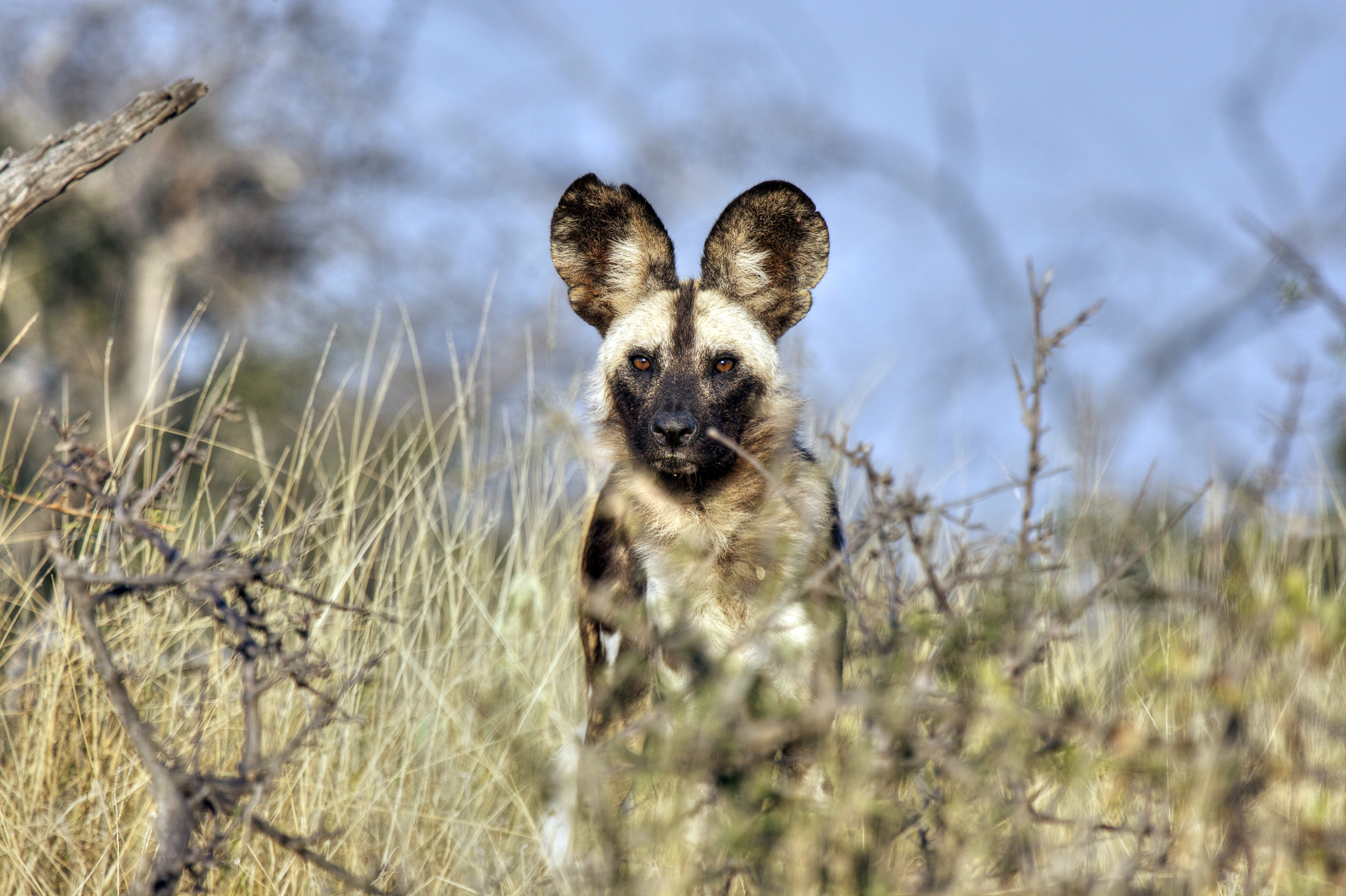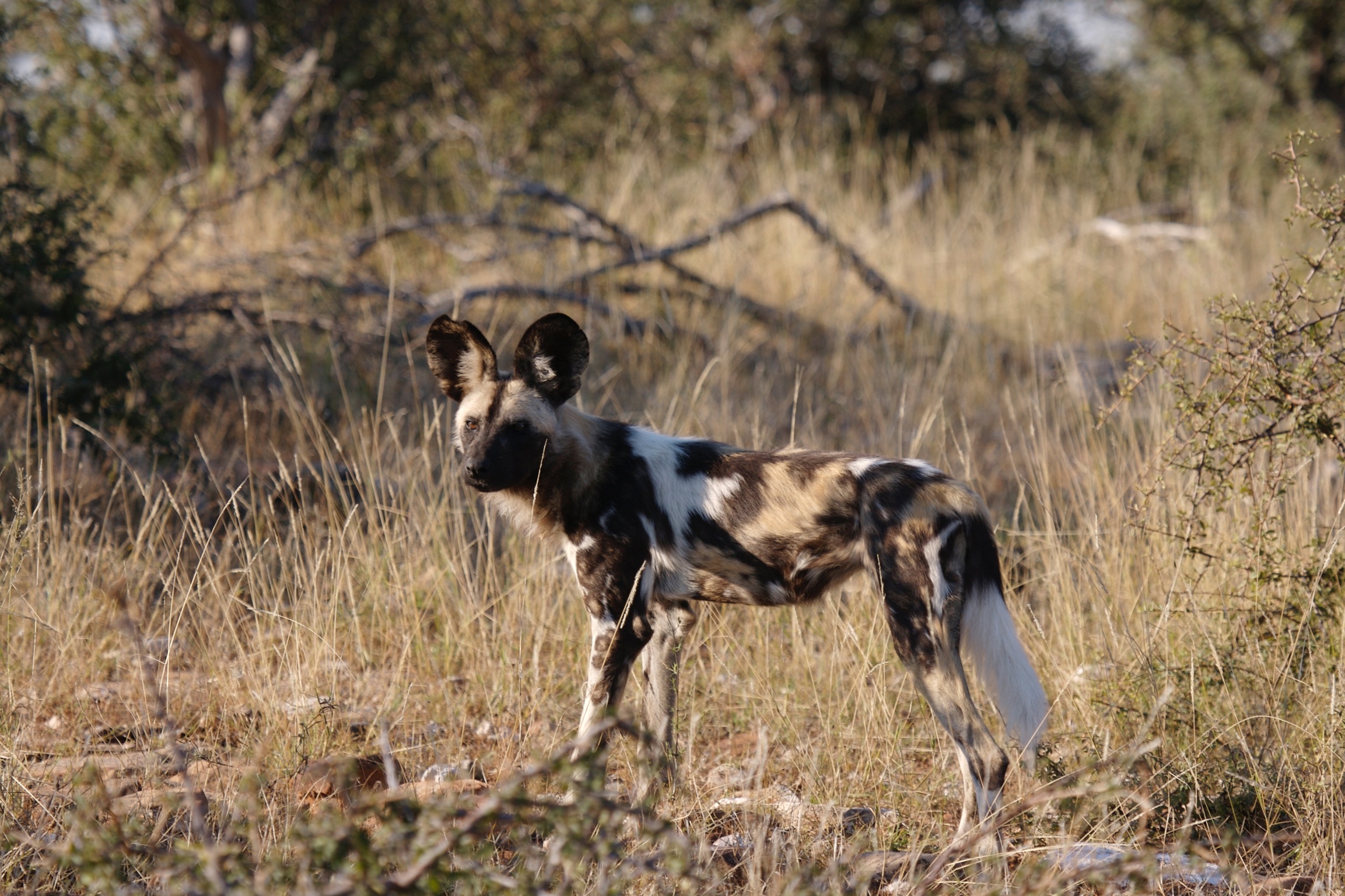Running with the Dogs
How did I go from filming Tiger Sharks to hanging off a Land Rover bumper on a dusty track in Botswana filming African Painted Dogs?
"This can't be right" thoughts flashed through my mind. "Jeez if the UK Health and Safety Executive could see me now". Picture this. I was being driven along at about 10mph, clinging precariously to the front end of a LandRover that was best described as 'insecure' while all the time trying to film a pack of African Wild Dogs using the dirt track as a hunting track. My 'chauffeur' was someone I'd only known a few hours and here I was entrusting my life to them. One slip and I'd have been mashed into the dusty covering of the Botswana savannah. Just a couple of days ago I was filming and placing camera on Tiger Sharks for the remote imaging department at National Geographic Television and Film. How in the heck did all of this come to pass?

The African Painted Dogs are one of the most enigmatic and curious of all pack animals on the African plains. Highly organized social structures allow them to be some of the most prolific and successful hunters throughout their rapidly diminishing domain.
The weather in South Africa had closed in, big time. I'd been tasked to work for six months with a selected few eminent marine scientists to document their work with Tiger Sharks that frequented the Alliwal Shoal MPA located just south of Durban in KwaZulu Natal. In short I would jump into a chum slick in the chance that I, or one of the scientists, could attach a small camera to the dorsal fin of a Tiger Shark! Easier said than done. This was to collect data on the sharks foraging behavior and to also get an idea of what their main prey items were and if possible, and incredibly lucky, to be able to document their hunting strategies.

For almost six months I bounced around Southern Africa in a LandRover named 'Pig'. Resplendent with AK47 'love bites' it was a labor of love to keep it on the road.
Having been banging away at this project for a couple of months the weather took a nose dive with no clear end in sight. So rather than sit around twiddling my thumbs I was re-tasked by the power that be in Washington DC, the HQ, to head up into Botswana where I would hook up with a young South African scientist working with African Painted Dogs. From my base in the small town of Umkomaas I struck north. It was a 1600km trek, I had the dark glasses and an extended range fuel tank full of gas. I hit it!
It was an eventful drive, one that involved a clutch breaking and thus having to master no clutch gear changes on an old manual diesel gear box. The stops at the Toll gates brought some surprised and, at times, panicked faces. It wasn't pretty. Breaking down on the wild side of the Limpopo River border lands saw me get taken in by a farmer and his family who, along with all their contacts, got 'Pig' back up and running within a couple of days. It never rains. 'Pig' being the name I'd affectionately bestowed on my ancient ride.
Needless to say I was somewhat relieved to eventually limp into my tasking location in what is called the Tuli Block conservation area in the SE segment of Botswana. I would be working on a tract of some 30,000 hectares for the foreseeable future. Or at least until the weather settled in Durban and the Oceans had time to calm to an extent that would allow diving activities to resume. I ended up spending some four weeks in Botswana, to underline just how temperamental the East Coast of Southern Africa can get when squalls blow in. In that time I would work with scientists and their target species, Elephants, Leopards and this initial task, African Painted Dogs. Absolutely stunning creatures for sure.
As I watched in the early dawn light, it was as if I was watching in slow motion. My arm and legs, I say arm as I had the camera in the free one, were straining to retain grip as we bounced along the path. I often have these crazy rigging ideas, how to get the shot with the least amount of fuss. If anyone is to get hurt in the process that would invariably be my good self. I just couldn't help it. My no nonsense approach mixed with the fact that here we were in the wilds of Africa without the H&SE looking over my shoulder suggested this was the best way to address this particular problem. How to film this pack of dogs as they hunted.

'Alpha' always a little distance but oozed confidence. The leader and brains of the pack. And just a little mischievous.
'Alpha' led the way, his beautiful coat with it's unique pattern and sheen veiled a muscular body, honed to predatory perfection on the plains of Africa. His scarred and ripped face paid testament to the hardships and battles faced, and won, on his trajectory to become the leader of his pack.
I could see the ripples of his muscular shoulders as he sauntered along the dusty path. This and other wild dog packs would use these dirt roads as resistance free tangents when hunting. With their communicative grunts and squeals they would form into what are highly coordinated group. It's almost as if they have a team play book for specific species as one would watch as pack members as if on cue would break off at certain points as a way to try and coral pursued prey towards certain geological formations such as a rocky outcrop, bottleneck of vegetation etc where other pack members would be waiting in ambush.
It was early morning, the dogs had been running for some 30 or so minutes. Almost superhuman stamina saw them simply adopt and maintain a brisk pace as they tried to chase down a large Eland, one of the larger Antelope species of the African plains. It was as if the pack were hunting via telepathic signals, such were the very obvious departures of specific members during the chase.
We started to slow after 45minutes. I had noted the faint but very audible sound of the dogs breathing. Slowing into a saunter it was evident the chase was no longer on. Slowly the pack reformed. Ritualistic and subservient behavior showed younger members acting very submissive to 'Alpha'. They would vocalize with almost chirping like squeals, accompanied by the licking of noses and canine prostrations to show their allegiance. To have spent such a short amount of time in their presence, and to have seen so much of their intricate social structure, was a true blessing.
Spending the next three weeks alternating between iconic species as well as documenting the endeavors of a manmade watering hole allowed me to take stock of the beautiful country that is Botswana. That is until I received word that the diving was back on in Durban, the Tiger Sharks were once again being seen in good numbers. And so having refilled the tank, put on my somewhat scratched a bruised dark glasses I once again pointed 'Pig' South and started out on my return trek. Being joined now by my then fiance, now wife Terue we struck out for Durban. A journey of less obstacles than the initial drive North, but one that in and of itself deserves a write up. But that, as they say, will be saved for another time. I had a date with some rather feisty Tiger Sharks to keep. Game on.

Filming Tiger Sharks in South Africa. A six month project that saw us successfully deploy numerous cameras on sharks to document their behavior. Our best day was clear water and 14 Tigers at one time, all around us. Mix that with upwards of 50 Blacktip, not the reef kind, Sharks and you get the picture. Craziness at times...
To see the 'Alpha' the pack leader who adorns the wallpaper behind this post simply click on the small circular icon with the opposing arrows in the top right corner of this page when you scroll to the top. Click a second time to return to the standard page view.
"No one will protect what they don’t care about. And no one will care about what they haven’t experienced".
Sir David Attenborough
About the Author
Internationally recognized as a provider of quality mixed media Mark Thorpe is always on the search for captivating content.

Photographer / Cameraman
Mark Thorpe
Emmy Award Winning wildlife cameraman and Internationally published landscape photographer Mark Thorpe has been an adventurer since he could walk! Spending 17yrs as an Underwater Cameraman at the start of his imaging career the highlight of which was being contracted to work with National Geographic. In that role as a field producer and cameraman he's been privy to a mixed bag of hair raising adventures. For some reason he was always selected for projects relating to large toothed marine predators such as Great White and Tiger Sharks, Sperm Whales and Fur Seals. Additionally he has also been active within Southern Africa on terrestrial projects dealing with a wide array of iconic wildlife.
Currently based in Okinawa, Japan he's always on the lookout for his next big adventure. He shares his exploits online with a totally organic social audience in excess of 200,000. Sponsored by a number of photographic industry manufacturers he is constantly scouring the islands for captivating landscape and oceanscape compositions. Videography wise he continues to create short photographic tutorial videos as well as creating content about the diversity of wildlife within Okinawa and the Ryukyu Islands of Southern Japan.
Mark has just created a Patreon channel where he's hoping to raise an audience of supporters who through small monthly shows of appreciation will allow him to concentrate on the creation of a wildlife and landscape imaging themed YouTube Channel. If you feel that is something you'd like to support you can visit his Patreon Channel for more information.
